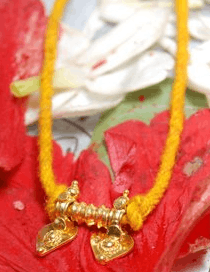Pushpaka
Pushpaka is a caste of Hindu Brahmins of Kerala.[1] In Malayalam language, this caste is also referred to as Pushpakan (in singular) or Pushpakar (in plural / to show respect). They are a part of the Ambalavasi community in Kerala and they are one of the major sects of Pushpaka Brahmins. They follow patrilineal system (makkathayam) of inheritance.
The male members of this caste generally use the title or surname Unni with their name and hence this caste is sometimes called Pushpaka Unni or Pushpakanunni.[2][3] They also use the surnames Nampi (also written as Nambi) and Sarma (also written as Sharma). The pushpakas who have adopted the title Nampi (or Nambi) are often referred to as Poonampi (or Poonambi). Pushpakas carry out the various activities of the temple like teaching of Sanskrit language and sacred texts in the Pathasalas associated with temples, bringing flowers for pooja, garland making, lightening the lamps, carry the lamp when idols are taken round in procession, distribution of prasadam and flowers, serving of consecrated water, preparation of food to be offered to deity, etc. They also perform actual priestly activities of the temple on behalf of the main priest.
Pushpaka woman, known as Atheramma or Pushpakathi, use the title Amma or Devi. They carry out temple services like making of garlands, bringing flowers for pooja, cleaning the temple lamps and vessels etc.
The house of a pushpakan is known as Madom or Veedu.
Customs

- The offspring of a Pushpaka by a woman of similar caste having marumakkathayam system (like Nameebsan, Puppalli, Kurukkal, Daivampadi etc.) were regarded as issue in a Pushpaka family and had to follow makkathyam system. Presently, all the above castes are practicing makkathayam system.
- The punyaha or purificatory ceremony after pollution for Pushpakas was performed through the agency of Namboothiris. At the present time, learned men from their own sect are employed for this purpose.
- Ilayatus were also employed by some sects of Pushpakas for priestly functions. The sections of the Pushpakas which have Ilayatus for their priests accept food from them, while the others do not.
- The punyaha of Nambeesans was performed by Pushpakans or Nambeesans themselves.
- In earlier days, as in the case of the Namboothiris, the Pushpanis cover their bodies with a piece of cloth, carry an umbrella, and are accompanied by Nayar servant-maids when they go out in public. The women had one more fold in their dress than that of the Namboothiris. The neck ornament of women was Cheruthalikkoottam, and the ear ornament was Kathila.
- Namboothiri women (Antharjanams) were not allowed to wear coloured dress. They were supposed to wear only white dress. They were not allowed to pierce nose. Further, a Namboothiri woman was not allowed to look at any man other than her husband, father, grandfather or her brothers on either side. Namboothiri women were not allowed to move out of the house without a maid. These types of restrictions were not generally observed by Pushpaka women.
- Brahmanis (women of Nambeesans) sing religious songs on the occasion of marriage among all castes from Kshatriyas to Nāyars. However, pushpaka women never go out to sing on marriage occasions.
- During Achamana, Namboothiris were not allowed to take bath before sunrise. Such a restriction was not observed by Pushpakas.
- In the wedding rituals (i.e. Vivaha), a Namboothiri bride always wear white dress while the Pushpaka bride will wear coloured dress, preferably red. The auspicious thread which is knotted around the bride's neck is referred to by Pushpakabrahmins as Mangalyasutra (Thali), whereas it is referred to by Namboodiris as Kanthasutra (Thali or Cheruthali). In a Pushpaka marriage, it is the groom who ties it around the bride's neck, whereas in a Namboodiri marriage, it is the bride's father who ties the Kanthasutra to bride's neck.
- Like Namboothiris, Pushpakas also wear only one "Poonool" (Yajnopaveetham, sacred thread) even after marriage, whereas Paradesi brahmins wear two sacred threads after marriage.
- Upon father's or mother's death, Namboothiris were bound to observe "Deeksha" for one year and at the end of "Deeksha" on the 12th month, Sapindi was performed. Pushpakas generally didn't practice this one year Deeksha.
Sayings or Phrases
There is a phrase in Malayalam "പുഷ്പകൻ മാല കൊരുക്കുന്നതുപോലെ" (puṣpakan māla korukkunnatu pōle) meaning "as a Pushpaka makes a garland". This phrase is used mainly while appreciating eloquent speeches, presentation of ideas in literature works etc.
See also
References
- ↑ Rose, Suma (2004). Polity, Society, and Women: With Special Reference to Travancore, 1700-1900 A.D. Carmel International Publishing House. p. 217. ISBN 9788187655374. Retrieved 2013-04-30.
- ↑ Census of India, 1901 Part 1-2. Census Commissioner, India. 1903. pp. 146–150.
- ↑ Iyer, L.A. Krishna (1995). Man in Kerala: Twelve Anthropological Essays Selected from Writings of (Padma Bushan) L.A. Krishna Iyer (also Incorporating Five Appendices). Centre for Training and Research in Anthropology & Management.